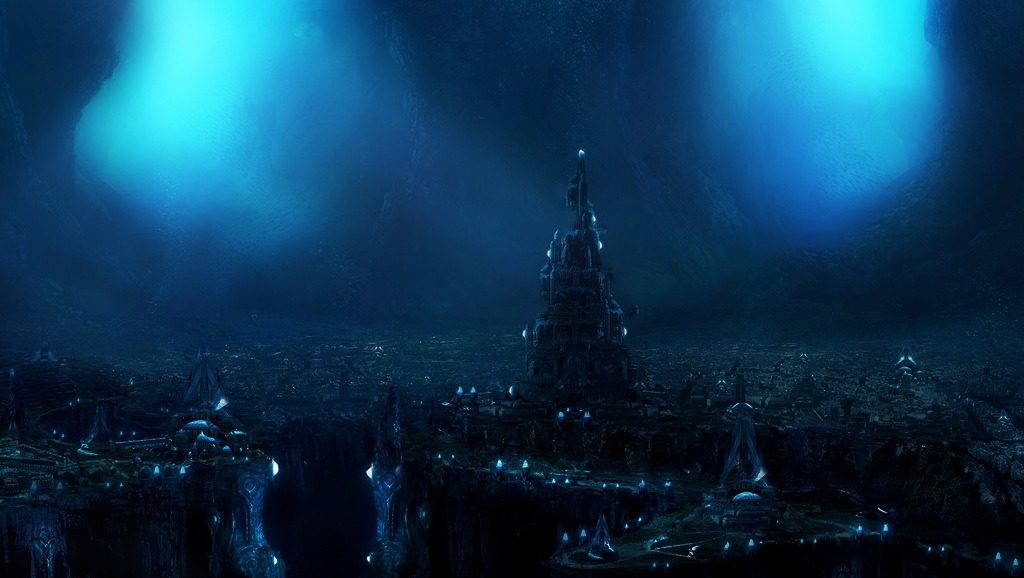The Bimini Road is a line of ancient stone formations under the sea. For years geologists, archaeologists, and scientists have argued if the limestone blocks are natural, or remnants of an ancient civilization lost to the eons of time. Bimini is an island in the Bahamas and is known for its crystal clear blue waters. The Bimini Road itself is a stone path 20 feet beneath the water. The rocks are huge, flat, and cut at right angles in what seems like a purposeful design. The end of the line of rocks has a distinct hook at the end, and the stones are pretty big, measuring up to 13 feet across. Some have come to call the stones the road to Atlantis.

The mathematics the Bimini Road presents are astonishing for ancient humans to achieve
The submerged paved road was first discovered by Joseph Valentine, a subsea archaeologist back in 1968. Since those days the site has been explored by innumerable researchers which lead to the discovery of two more linear roads nearby. Since the idea of Atlantis is so prominent in the universal psyche of western culture, when the discovery was made, it’s no wonder the Bimini Road exploded in a storm of publicity. Everyone in the world was crossing their fingers that Atlantis had finally been found. While the site didn’t prove to be as grand as all that, it did lead to heated debates among scientists for decades. After all, 95% of the underwater world remains unexplored, we know more about space than the depths of our own oceans, so the possibilities of discovery are limitless. The Bimini Road is just the tip of the iceberg of enigmatic mysteries yet to be discovered by humanity that lay beneath the waves.
[the_ad_placement id=”manual-2″]
There are different perspectives concerning the stones from all aspects of the intellectual and scientific communities. On one side, there’s those who’ve concluded the stones are around 11,000 years old, which according to journalist and researcher Graham Hancock, places the stones being built around the time of pre-cataclysm Earth, back when the area was above water. Coincidentally this is also around the time that Plato said Atlantis existed. The flat rocks are cut at right angles that don’t appear to be natural. The distinct hook formation of stones at the end makes the whole Bimini Road appear like the letter J. Many claim the distinct bend in the road is proof it was engineered, and not randomly formed by nature. One rock analyzed at the University of Colorado had tool marks on it, a sign of deliberate shaping. When stones were tested with other stones in the general area, the Bimini stones were missing elements to a degree the other stones possessed. Which indicates the stones were formed elsewhere, then moved to that location. There are smaller stones piled on top of larger ones, with spacing and curves, which has lead many to think the Bimini Road is a man-made formation of an unknown civilization.

Just look at the size of those stones. How could they have possibly been transported?
The other side of the camp say the Bimini Road is a natural rock formation and any sign of tools or human modification are from divers who went down there and did it themselves. They say the formation was created by sediment and water erosion, a natural phenomenon. Which is totally possible other than there is no place in the world where beach rock has formed naturally into organized lines, especially right angles.
[the_ad_placement id=”manual-2″]
What also throws a wrench in the gears of the whole naturally formed theory is that in 2006 Dr. Greg Little led a team of researchers to the site, and discovered a second layer of cut rocks underneath the first layer with similar dimensions, giving the impression the Bimini Road could have been a wall. Some stones were even heart-shaped or had unnatural holes that seemed to be drilled into them. Dr. Little believed those stones were used as some sort of anchor and the Bimini Road could have possibly been some type of docking construction for ships.
[the_ad_placement id=”manual-2″]
Despite all Dr. Little’s discoveries geologists still tried to argue that the stones were a natural formation. However, if it’s a natural formation, the Bimini Road is the rarest natural formation of rocks ever in the history of anything. The fact that the Bimini Road cannot be disproved as an artificial formation even by the most hardened skeptics is food for thought. Also, legitimate evidence it’s a man-made structure is made fun of and pushed under the rug by the gutter press, so there’s that too. Even today you can Google Bimini Road and find “scientists” who claim it is a natural formation with no objective evidence to back it up, but that’s okay because most intelligent people understand that mainstream information is not nearly as reliable as the herd of humanity thinks it is.

The road to Atlantis?
It’s a shame more extreme excavations can’t take place because the strong gulf stream in the area makes underwater work on the site very difficult and incredibly dangerous. Many people have been killed in different underwater expeditions. Bimini Road is an incredibly deadly archaeological site to research. Only the very brave who also happen to be expert divers can truly explore the Bimini Road.
[the_ad_placement id=”manual-2″]
In 2002, author Gavin Menzies released his book titled 1421: The Year China Discovered the World. In the book, Gavin presents a theory that the site might be of Chinese origin. The Chinese Imperial Fleet explored the Caribbean from 1421 until 1423. He speculates that ships could have been damaged in a storm, and the Chinese built emergency dry docks to repair themselves. Six centuries ago, the water level in the area was six feet lower at the Bimini Road. According to Gavin, the Bimini stones would have been much closer to the shoreline, making them an excellent impromptu dry dock for a fleet of 1,400 ships, and Dr. Little’s research team did discover another layer of rocks beneath the top ones with holes drilled through them, which could totally have been used for ship docking. Sadly there’s not enough evidence to prove the Chinese fleet theory, but it’s definitely a possibility. Gavin’s theories are an interesting take on the origins of Bimini Road and perfectly falls in line with the fact that the formation is man-made.
[the_ad_placement id=”manual-2″]
Though completely unscientific, another interesting twist on the story of Bimini Road has to do with a famous 20th-century mystic. His name was Edgar Cayce, a well known and prolific modern prophet to many believers. Some even put him on par with the enigmatic Nostradamus from medieval fame. Cayce actually put in a lot more work than Nostradamus, performing 14,000 documented psychic readings. The cool thing about Cayce was he never charged any money whatsoever for any of these readings, or prophesies of world events. Which actually gives him a lot more credibility than almost any psychic because he wasn’t out for fame or cash and actually only suffered for following his chosen life path.

Edgar Cayce had many interesting theories and visions concerning humanity
Whether one believes in psychic abilities or not, this factor definitely makes the man interesting. He would go to help people in difficult times or who were suffering without question, and really all evidence points toward the guy having a strong character with immense empathy towards others. Cayce allegedly had the ability to go into meditative trance states that would reveal to him accurate information regarding the past, present, and future. In one of these instances, Cayce had a vision of what could universally be translated as Atlantis. Cayce saw the discovery, history, and destruction of this pre-history advanced civilization, and even gave specific details about its future discovery. He said sunken land would appear in our time, and this is a quote from the man back in 1938:
“A portion of the temples may yet be discovered under the slime of ages and seawater near Bimini. Expect it in 1968 to 1969- not so far away.”
Now, that’s a very specific prophecy right there. Not one of those vague maybe this, maybe that, cryptic predictions most charlatans give, but a very specific location and date. The Bimini Road was discovered off the island of Bimini in 1968, confirming the prediction made by Cayce in 1938. The man also had a lot to say about humanity’s past concerning Atlantis. Cayce said the civilization was technologically superior to our current modern society, and that its last surviving outposts sank under the ocean over ten thousand years ago, perfect timing for the end of the last ice age, and the cataclysm that flooded the world.

There is objective evidence of a cataclysm that occurred around 10,000 years ago
Cayce claimed modern humans were a race with amnesia and showed a mere shadow of true human potential. Atlantis fell from the disintegration of their culture due to greed and entropy, and a disrespect for the need for a balance between technology, spirituality, and nature. But, before the civilization sunk beneath the waves, there was an exodus by Atlanteans who foresaw the doom. The biblical flood, as well as flood myths from all over the world, happened because of the destruction of Atlantis, and most human civilization was wiped out, throwing us into a dark age. Those few survivors journeyed to places like Egypt, to re-start civilization. Though Cayce presents an interesting look at the Bimini Road, it is the words of a psychic, so it leaves much in want for objectivity. However, the exact date and location Cayce predicted the Bimini Road would be discovered is pretty unbelievably amazing.
[the_ad_placement id=”manual-2″]
There’s much still to be discovered about the Bimini Road, and as our technology advances so too will our understanding of it. Also, people who try to say it’s a natural formation are definitely full of it, and thinking it’s a remnant of Atlantis is wishful thinking, to say the least. However, evidence would dictate it was indeed left behind by some unknown civilization. Be it the Chinese or some other culture lost to time.

I really wish it was Atlantis…




0 Comments